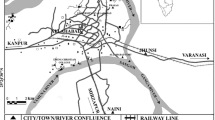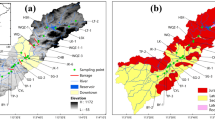Abstract
On steep, unvegetated slopes, sands (particle sizes 0.063 to 2 mm) and gravels (2–64 mm) erode from the shoreline of Lake Naivasha (Kenya) and enter the lake basin. This occurred freely where fringing papyrus (Cyperus papyrus) swamp had been cleared in favour of landing jetties or agriculture. Gravel-sized particles have been recovered up to 60 m offshore and sands to 80 m. In an area where papyrus was undisturbed and the swamp margin was 52 m wide, gravel did not enter the lake and sands penetrated to around 35 m. Large particles are much easier to trace to source and to manage than the finer silts and clays (<0.63 μm) that form the bulk of Lake Naivasha's sediment. The pattern of mass specific magnetic susceptibilities for the <63 μm fraction of lake sediment around the southern shoreline of the lake suggests that fine particles enter open water directly from the shoreline and are not transported from the lake's only perennial inflow, the River Malewa in the north. Such particles originate from a hinterland that supports high intensity horticulture and are therefore a potential source of contamination. Mean ± SD susceptibility (χIf) immediately offshore papyrus fringe was 0.49 ± 0.08 × 10-6 m3 kg-1 compared with higher values of 1.33 ± 0.14 × 10-6 m3 kg-1 where there was no papyrus barrier (P<0.0001). The value for five sites in the middle parts of the lake was 0.45 ± 0.02 × 10-6 m3 kg-1 with 1.38 ± 0.10 × 10-6 m3 kg-1 near the mouth of the River Malewa. The results of this study are evidence, therefore, that conservation of a continuous papyrus margin of about 50 m width is a priority for intercepting particulate material.
Similar content being viewed by others
References
Åse, L-E., K. Sernbo & P. Syrén, 1986. Studies of Lake Naivasha, Kenya, and its drainage area. Forsk. Naturgeogr. Inst. Stockholm University 33: 1–77.
Boar, R. R., D. M. Harper & C. S. Adams, 1999. Biomass and its allocation in Cyperus papyrus in a tropical wetland, Lake Naivasha, Kenya. Biotropica 31: 411–421.
Clark, F., A. Beeby & P. Kirby, 1998. A study of the macroinvertebrates of Lakes Naivasha, Oloidien and Sonachi, Kenya. Rev. Hydrobiol. Trop. 22: 21–33.
David, C., J. A. Dearing & N. Roberts, 1998. Land use history and sediment flux in a lowland catchment, Groby Pool, Leicestershire, U.K. Holocene 8: 383–394.
Dearing, J. A., 1979. The Use of Magnetic Measurements to Study Particulate Flux in Lake-Watershed Ecosystems. PhD thesis, University of Liverpool, U.K.
Dearing, J. A., 1999. Holocene environmental change from magnetic proxies in lake sediments. In Maher, B. A. & R. Thompson (eds), Quaternary Climates, Environments andMagnetism. Cambridge University Press: 354 pp.
Gaudet, J. J., 1979. Seasonal changes in nutrients in a tropical swamp: North Swamp, Lake Naivasha, Kenya. J. Ecol. 67: 953–981.
Harper, D. M., 1992. The ecological relationships of aquatic plants at Lake Naivasha, Kenya. Hydrobiologia 232: 65–71.
Harper, D. M., C. Adams & K. M. Mavuti, 1995. The aquatic plant communities of the Lake Naivasha wetland, Kenya: pattern, dynamics and conservation. Wetland Ecol. Manage. 3: 111–123.
Hilton, J., 1990. Greigite and the magnetic properties of sediments. Limnol. Oceanogr, 35: 509–520.
Hilton, J. & J. P. Lishman, 1985. The effect of redox changes on the magnetic susceptibility of sediments from a seasonally anoxic lake. Limnol. Oceanogr. 30: 907–909.
Kenya Soil Survey, 1982. Exploratory soil map and agro-climatic zone map of Kenya, 1980. Exploratory Soil Survey Report No. E1, Kenya Soil Survey, Nairobi: 56 pp.
LNRA, 1999. Lake Naivasha Management Plan. The Lake Naivasha Riparian Association (LNRA), P.O. Box 1011, Naivasha, Kenya: 77 pp.
Maher, B. A., 1988. Magnetic properties of some synthetic submicron magnetites. Geophy. J. Royal Astron. Soc. 94: 83–96.
Muchiri, S. M. & P. Hickley, 1991. The fishery of Lake Naivasha, Kenya. In Cowx, I. G. (ed.), Catch Effort Sampling Strategies: their Application in Freshwater Fisheries Management. Fishing News Books, Blackwell Scientific Publications, Oxford: 382–392.
Muchiri, S. M., P. Hickley, D. M. Harper & E. North, 1994. The potential for enhancing the fishery of Lake Naivasha, Kenya. In Cowx, I. G. (ed.), Rehabilitation of Freshwater Fisheries. Fishing News Books, Blackwell Scientific Publications, Oxford: 348–357.
Oldfield, F., B. A. Maher & P. G. Appleby, 1989. Sediment source variations and lead-210 inventories in recent Potomac Estuary sediment cores. J. Quat. Sci. 4: 189–200.
Smith, J. P., 1999. An introduction to the magnetic properties of natural materials. In Walden, J., F. Oldfield & J. P. Smith (eds), Environmental Magnetism: a Practical Guide. Technical Guide, No. 6, Quaternary Research Association, London: 5–34.
Snowball, I. F., 1994. Bacterial magnetite and the magnetic properties of sediments in a Swedish lake. Earth Planet. Sci. Lett. 126: 129–142.
Tarras-Wahlberg, H., 1998. Investigations of Sediment Geochemistry in Rivers in the Lake Naivasha Catchment. University of Leicester/Earthwatch Institute Report: 11 pp.
Tarras-Wahlberg, H., 1999. Investigations of Sediment Stratigraphy and Sediment Geochemistry of Lake Naivasha, Kenya. University of Leicester/Earthwatch Institute Report: 14 pp.
Thompson, R. & D. J. Morton, 1979. Magnetic susceptibility and particle-size distributions in recent sediments of the Loch Lomond drainage basin, Scotland. J. Sed. Petrol. 49: 801–811.
Thompson, R., R. W. Battarbee, P. E. O'sullivan & F. Old-field, 1975. Magnetic susceptibility of lake sediments. Limnol. Oceanogr. 20: 687–698.
Verschuren, D., 1999. Sedimentation controls on the preservation and time resolution of sedimentary climate-proxy records from shallow fluctuating lakes. Quaternary Science Reviews 18: 821–837.
Verschuren, D., C. Cocquyt, J. Tibby, C. N. Roberts & P. R. Leavitt, 1999. Long-term dynamics of algal and invertebrate communities in a small, fluctuating tropical soda lake. Limnol. Oceanogr. 44: 1216–1231.
Walden, J., 1999a. Magnetic susceptibility. In Walden, J. F. Old-field & J. P. Smith (eds), Environmental Magnetism: a Practical Guide. Technical Guide, No. 6, Quaternary Research Association, London: 35–62.
Walden, J., 1999b. Remanence measurements. In Walden, J., Old-field F. & J. P. Smith (eds), Environmental Magnetism: a Practical Guide. Technical Guide, No. 6, Quaternary Research Association, London: 63–88.
Author information
Authors and Affiliations
Corresponding author
Rights and permissions
About this article
Cite this article
Boar, R., Harper, D.M. Magnetic susceptibilities of lake sediment and soils on the shoreline of Lake Naivasha, Kenya. Hydrobiologia 488, 81–88 (2002). https://doi.org/10.1023/A:1023357910441
Issue Date:
DOI: https://doi.org/10.1023/A:1023357910441




